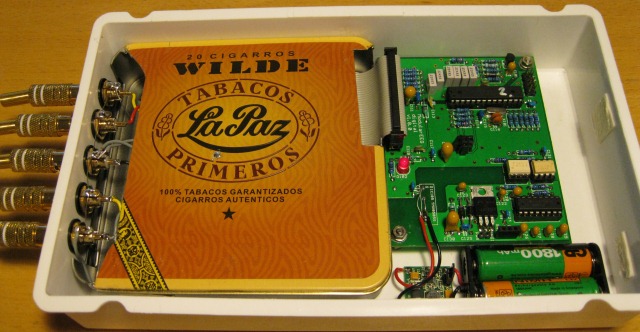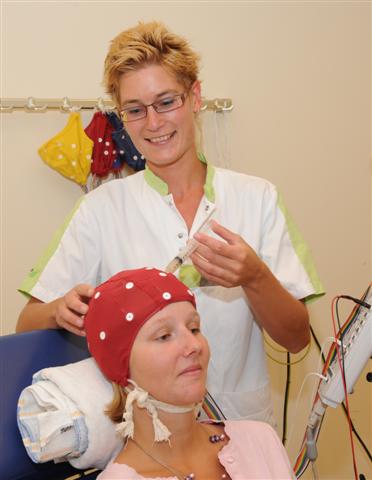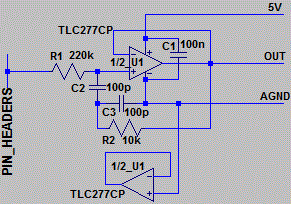
Under construction May 2012
Introduction
This page is about my home build portable EEG system. It can measure brain activity. The EEG sensor consist of 4 dry active electrodes. The EEG signal is buffered at the sensor and then fed to the amplifier and the digitizer. An analog amplifier board and a digital AD conversion board were build inside a lunchbox therefore it is called the lunchbox EEG. The boards were designed in the OpenEEG project. The measured EEG is sent wirelesly to the PC. On the PC a programs run that further processes the EEG signal to further filter, display and record usefull EEG signals.
Below is a picture of my lunchbox EEG.

Electroencephalography (EEG) is the recording of electrical activity along the scalp. EEG measures voltage fluctuations resulting from ionic current flows within the neurons of the brain. In conventional scalp EEG, the recording is obtained by placing electrodes on the scalp with a conductive gel or paste, usually after preparing the scalp area by light abrasion to reduce electrical impedance due to dead skin cells. Then the signal is led through 1 meter long cable before it is amplified.
Below is a picture of a convential EEG cap using many passive electrodes.

However my lunchbox EEG uses dry active electrodes that amplifies the EEG 1x just millimeters from the scalp. This amplifier reduces the output impedance and as a result the signal is less sensitive for electrical disturbance on the cables towards the amplifier. The electrodes that I made are actually gold plated pin header connectors, that you can buy in every local radio shack, soldered to small piece of experimental holes PCB. Because of these pin headers the electrodes can be easily worn over hair. The analogue board of the ModularEEG has two channels. Each channel (i.e., waveform) represents the difference between two adjacent electrodes. To create two channels, four electrodes are required. The amplified signal is, after being passed through an anti-aliasing filter fed to an analog to digital converter. In the ModularEEG digital board sampling occurs at 256 Hz. The ModularEEG allowes maximal three analogue boards to be connected to the digital board, thereby creating 6 channels. My lunchbox EEG uses only one analogue board.
Pictures of my dry active electrodes.


Below: Schematic of my dry active electrodes. The active electrodes described here correspond to the circuit diagram suggested by Joerg Hansmann.

In the original design the ModEEG boards are powered with a 5V wall-mart power supply and electrically isolated using the on-board isolated 5V-5V converter. The serial communication to the PC is done using a pair of RS-232 ICs and optical isolation PC using two optocouplers. My lunchbox EEG is powered by a pair of 1.5V AA batteries. A small step-up converter from Bodhilabs.com creates 5V that is accepted by the ModularEEG boards. In addition my lunchbox EEG communicates to the PC via a wireless serial connection using a pair of XBee modules (2.4 GHz 1mW Series 1). Because of the isolated power supply and the wireless connection the lunchbox EEG is electrically safe.
TO DO: place information wrt used programs and some screendumps indicating currect functioning of the hardware and usefull EEG feedback.